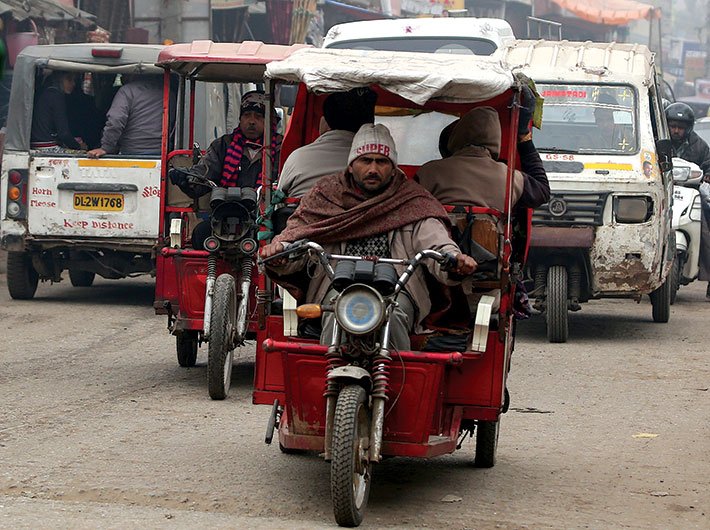In a season of bans in India, the one on e-rickshaws in Delhi is being lifted. The travails of e-rickshaw drivers show the tricky nature of regulations in the country
Shree Bhagwan Jaiswal pushed the pedals of his cycle rickshaw in Old Delhi for more than 20 years. As the sole breadwinner of his family – he is a father of four – there was no way out. “It is drudgery. Ask any cycle rickshaw driver to walk; he will give up after two minutes,” he says. Shortly after his three daughters got married, he began weighing his options.
That was before the 2010 Commonwealth Games. The Congress government in Delhi was tidying up the city, trying to give it the feel of a ‘world-class city’. Rickety cycle rickshaws were not proper, so it encouraged e-rickshaws running on batteries. Chief minister Sheila Dikshit and other political bigwigs openly endorsed such vehicles. Commuters preferred e-rickshaws because of the low fares and ready availability. For 60-plus Jaiswal, e-rickshaw was it. The vehicles ran smoothly, were easy to operate and the return on investment was good. Early in 2013, he tried an acquaintance’s e-rickshaw and decided to buy himself one, too.
Just that he was behind the curve. Their popularity had driven up the price of e-rickshaws to '89,000. Jaiswal wanted to be careful. He considered the costs and opportunities, consulted friends and family, and then took a loan of '70,000 from someone in his locality. The due diligence paid off. “I began earning '700 per day. I paid back the debt within a few months.”
Jaiswal’s happiness was short-lived, though. For early in 2014, a social worker filed a public interest petition in the Delhi high court, seeking a ban on e-rickshaws because they were unregulated. They were not registered, they did not follow traffic norms, and overloading was common, argued the petitioner Shahnawaz Hussain, who is identified merely as a social worker. E-rickshaw operators say Hussain is invested in the older cycle-rickshaws. All efforts to contact him from Governance Now were fruitless.
Since the petition, it had been a downhill journey for Jaiswal. The ministry of road, transport and highways declared e-rickshaws illegal in a notification of April 24, 2014. This created discontent among the e-rickshaw drivers like Jaiswal. This unrest was bound to become a political issue, given that the Delhi assembly elections were due. The BJP took up their cause. Anand Sahu, state president of the BJP-supported Mazdoor Morcha of Delhi, became the convener of the Delhi Battery Rickshaw Chalak Union.
Transport politics
On June 17, 2014, the new transport minister, Nitin Gadkari addressed a large rally of e-rickshaw owners and drivers at Ramlila Maidan. He announced e-rickshaws will not be barred from operating in the national capital, and that they will continue to be treated as non-motorised transport. The municipal corporations of Delhi were to register them with a fee of '100, as also to formulate a policy for their smooth operation. Elated rickshaw owners went back to work. But, again, their joy did not last. On July 31, 2014 following a fatal accident, the Delhi high court banned e-rickshaws for good. Keeping in mind the impending Delhi state elections, the government was forced to device a policy for e-rickshaws.
Despite the ban, unregulated e-rickshaws were sold openly in Paharganj. The vehicle parts, all from China, were assembled in shops out front. The shop owners said then that the orders were from Delhi’s satellite localities in Uttar Pradesh. The reporter visited three shops where the price quoted for the vehicles ranged from '65,000 to '85,000. The payment had to be made in cash, though one dealer agreed to a debit card. The bargains were tough but negotiable. There was the added assurance of proper receipts accounting for government taxes.
Jaiswal noticed that every action of the government had benefitted the manufacturer and seller of e-rickshaws. “Immediately after Gadkari’s Ramlila Maidan speech, the manufacturers made a killing as people rushed to buy more vehicles,” he says. Some drivers deride the BJP’s support. “E-rickshaw manufacturers are holding important positions in the union. They are the big fish who have to be addressed. When we figured this out we wanted to launch a protest against the transport minister. But each time we tried, our attention was diverted by some show of solidarity, such as approaching the human rights commission,” says Jaiswal.
How did he meet his household expenses during the ban? Some nights, he sneaked out to operate his e-rickshaw. It was illegal then but he earned about '200 per night. For the most part, though, Jaiswal had to fall back on his savings. Did he consider going back to operating a cycle rickshaw? “Once you drive an e-rickshaw it is impossible to go back to a cycle rickshaw. You get habituated to the comfort.”
Meanwhile, a new government has taken charge of Delhi. The Aam Aadmi Party’s government is drafting a bill to pave the way for the return of e-rickshaws.
Also, in January 2015 the president signed an ordinance to amend the Motor Vehicles Act, making it possible to ply e-rickshaws on Delhi’s roads. Under the new rules, e-rickshaws can carry no more than four passengers and 40 kg of luggage, while e-carts would transport goods up to 310 kg. On February 24, 2015, Delhi’s transport department started the process for ensuring the plying of e-rickshaws in Delhi by initiating licensing and registration process through facilitation camps. In these camps, all the interested e-rickshaw owners and drivers can contact their respective motor licensing offices, and can apply for learner’s licences and public service vehicle (PSV) badge respectively.
Meanwhile, the Lok Sabha passed the amendment to the Motor Vehicle Act on March 3, followed by the Rajya Sabha on March 11, ending the confusion over the legal status of the e-rickshaw.
After all the ups and downs, it seems the administrative apparatus may do the right thing, finally. Why did it take so long to heed to commonsense? Ask Priyanka Diwakar.
Safety is a precursor to mobility
Diwakar’s PhD thesis is titled ‘Role of e-rickshaw under para-transit domain in urban areas’, which she submitted to the School of Planning and Architecture in Delhi. She says e-rickshaws provide the solution for the perennial problem of last-mile connectivity. “In small cities they function as a main-line haul, whereas in metro cities, 80 percent of e-rickshaws work as feeders to other modes of transport,” she says. Lack of proper stands and inadequate controls on e-rickshaws causes congestion. Diwakar says they provide economic opportunity and employment. Jaiswal agrees: “It has offered a respectable alternative to many young men who were petty criminals, to disabled people, and to women.” After rent and vehicle operating costs, a driver can save about '16,000 a month.
Yet the vehicles do not last long due to the poor quality of their parts, which makes them accident-prone and requires frequent repair, says Diwakar. Several drivers verified that the batteries do not last more than six months. The battery cost is a problem, too. The cost of replacing them varies between '20,000 and '28,000, depending on the quality. Which is a matter of international trade.
Neelab Jha, CEO of Nabh Motors that makes and sells e-rickshaws in West Bengal, says the cost of parts sold in India by Chinese companies is higher than what they cost in China. “The quality of the Chinese products is poor and they come without warranty. Moreover, getting a loan for manufacturing is difficult. The interest rates are higher in India,” he says. Nabh Motors sells each vehicle for '1,15,00. Jha feels without domestic manufacturing, direct control over vendors is impossible. “People are increasingly localising the production to meet the regulatory standards. With the regulations the quality of the vehicle will improve,” he says.
The e-rickshaw motors need rare earth magnets over which China has a monopoly, says Sudipto Mukherjee, professor of mechanical engineering at the Indian Institute of Technology, Delhi. “The process of mining these materials is extremely caustic to the environment. Initially, when there was a demand for it, they started mining these metals. Now they have changed their export policy. They do not export isolated magnets. Instead, the consumer has to import the motors.”
Mukherjee said that the vehicle structure can be improved through research efforts. The upcoming facilities of the National Automotive Testing and R&D Infrastructure Project (NATRiP) can boost the safety of the vehicles. “For a low-cost mode of transport, the returns are very low. Hence we must ensure safety. When people from this class [users of low-cost transport] get hurt while travelling in these vehicles, they cannot afford proper medical treatment,” he says. “People have just ensured mobility. But safety is a precursor to mobility.”
The transport ministry’s rules require the net power of the e-rickshaw motor restricted to 2,000 Watts (proposed at 4,000 Watts in the bill) and the vehicular speed limited to 25 kmph. Mukherjee says in China, the motor’s power is restricted to 250 watts and the speed is limited to 20 kmph. Experimental data suggests 36 kmph is the threshold speed, beyond which fatality rates sharply rises.
“If these vehicles ply in a crowded area, they are unlikely to exceed the safe speed. Standard vehicles are designed extensively for safety. They have seat belts, cushions, dashboard and yielding surface. Just speed limit does not guarantee safety. It has to be coupled with rigorous design,” he says. He further says that if these vehicles run on a three-lane road like Delhi’s Aurobindo Marg, which is fairly empty barring office hours and where cars routinely barrel down at speeds of 60-70 kmph, the probability of fatal accidents increases. But it is ideal for internal transit through colonies where speeds are lower. “Instead of leaving it to the drivers to regulate the speed, they should be limited by the controller,” he adds.
Do such vehicles cause traffic problems? Anil Shukla, additional commissioner of police (traffic), says that multi-modal transport is competing for the same road space at the same time. “E-rickshaws should have adequate braking strength, insurance, licence, head and tail lights, and verified drivers. We are against it because till now there are not adequate parking spaces and halt-and-go spots. Unless there is a proper licensing process, we cannot screen out the illegal drivers,” he says.
“E-rickshaws have to be definitely kept out of arterial roads,” he adds. That said, these vehicles are wonderful modes of last-mile connectivity, given the poor public transport system in deep colonies, says Shukla.
There is no doubt about the demand for the service they provide. Diwakar’s research found a chunk of commuters embracing e-rickshaws. About 59 percent of users in New Delhi Railway Station area, 50 percent in Delhi University and 41 percent in Chandni Chowk shifted to e-rickshaws because of their relatively high speed and low fare. Besides, they do not pollute the ambient air.
Yet last-mile connectivity will remain difficult if e-rickshaws are kept away from main roads. In most areas of the city, metro stations or the bus stops are some distance from the residential areas. The feeder concept works where the station is at an intersection and the distance between the grids is roughly one kilometre. The ordinance gives relief to the e-rickshaw drivers. But the safety requires a combined effort at urban planning. Jaiswal is already a small part of that effort. He has applied for a learner’s licence. He volunteers at facilitation camps to help over one lakh e-rickshaw drivers secure their livelihood.
puja@governancenow.com
(The article appears in the March 16-31, 2015, issue)

